Section 1
Introduction
Section 2
The Maestro Interface
Section 3
Defining a Job
Section 4
Defining Recipients
4.2 Source
-
Tip Databases
Section 5
Defining Content
Section 6
Defining Tracking
Section 7
Sender and Delivery Options
Section 8
Outbox
Section 9
Delivered Jobs
Section 10
Reporting and Statistics
Section 11
User Settings
Appendix A
24 Hour Clock
Appendix B
International Character Sets
Appendix C
Comma Separated Files
Appendix D
AOL Rich Text
The next step is to define or upload a "Source" for the recipient data. Depending on the Options selected in the previous screen, different prompts will appear as the Source screen, requesting different information in order to create the recipients list.
4.2.1 Uploading a Recipient Text File
By choosing the option "Upload a Recipient Text File," the Source screen that opens contains a clickable link Upload a recipients file, to upload a text file from a local drive. Browse for the file on a local drive and choose the encoding for the file if necessary. For more information on encoding, see Appendix B E-mail and International Character Sets.
Figure 9 Define Recipients from an Uploaded File


Once a file had been uploaded to LISTSERV Maestro, the information about that file will appear on the screen. The link to upload a file will change to Upload a different file after one file has successfully been uploaded to the system. Click Next -> to continue or <- Back to return to the previous page.
4.2.2 Selecting Recipients From a Database
Choosing the option "Select Recipients From a Database" for a new job opens a Source screen that requires the selection of a database plugin and entering a SQL statement. The SQL statement is entered in the text box at the bottom. SQL statements can be copied and pasted into this text box from another source.
Database plugins are available from L-Soft and should be installed by the system administrator when LISTSERV Maestro is first installed. These plugins allow LISTSERV Maestro to communicate with many different types of databases. If there is any uncertainty about the selection of database plugins, contact the system administrator, the database administrator or see Section 9 in the LISTSERV Maestro Administrators Guide.
Figure 10 Define Recipients from a Database
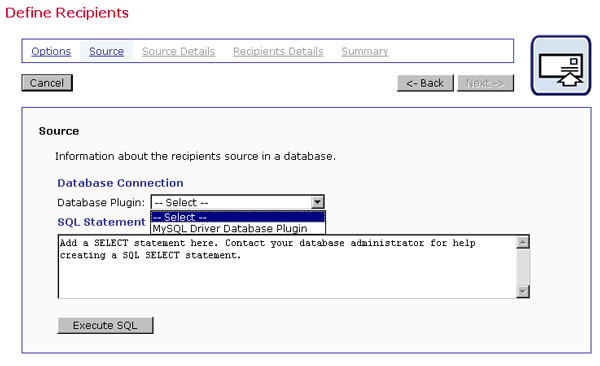
Once the database plugin has been selected, a longer Source screen opens requiring additional information. If there is any question about the information required, contact the database administrator or the system administrator. This longer version of the Source screen will automatically open (skipping the shorter version) if the new job is copied from a previous job with the same settings, or if the user returns to the Source screen from another link in the recipients wizard. The wizard does not have to be completed in order to keep the plugin selected.
Figure 11 Define Recipients from a Database - Define Database Connection
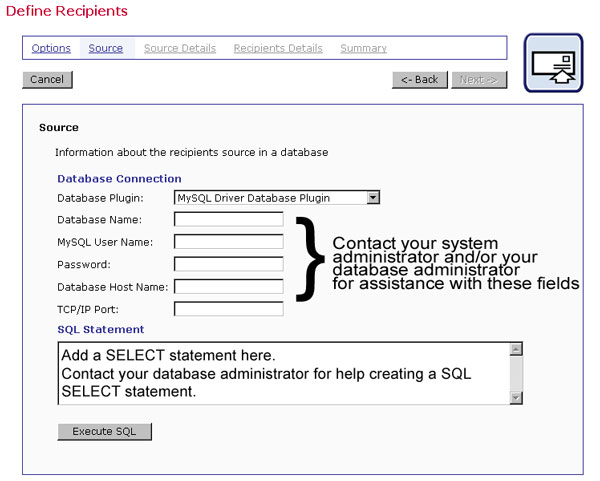
Click Execute SQL to continue. It may take some time to execute the SQL statement, depending on its complexity. If this is the case, a processing screen will appear until the operation is completed. If the SQL statement has been successfully executed, the message "The SQL Statement was executed successfully. Press the Next button to continue." will appear at the bottom of the screen. (If the SQL statement was not successfully executed, an error message will appear at the top of the screen.) Click Next -> to continue.
![]() Although
initially it may take some assistance from the system administrator or
database administrator, selecting recipients from a database is a much
faster method of defining recipients for a job when compared to uploading
a text file. Because recipient data comes directly from a database, it
becomes unnecessary to export the data, upload a large text file, and
parse the file, therefore
saving time.
Although
initially it may take some assistance from the system administrator or
database administrator, selecting recipients from a database is a much
faster method of defining recipients for a job when compared to uploading
a text file. Because recipient data comes directly from a database, it
becomes unnecessary to export the data, upload a large text file, and
parse the file, therefore
saving time.
4.2.3 Sending to an Existing LISTSERV List
The option "Send to an Existing LISTSERV List" uses the identified list’s subscriber names and addresses to create the recipient list for the e-mail job. There are two options here: to send the message as a "standard list message" to subscribers (which will limit the tracking options), or as a "special list message" that allows for mail merging and more tracking options.
If the message is sent as a standard list message, the "From:" address field in "Define Sender" must be an authorized sender for that list. If the message is sent as a special list message, then the LISTSERV Maestro e-mail address must be an owner of the list. By choosing "Send job as special list message" an additional link, Special distribution options available here becomes active. Click this link to expand the screen and display conditions and options for the list. The screen needs to remain expanded in order to use the selections made in the expanded version.
Figure 12 Define Recipients from a LISTSERV® List
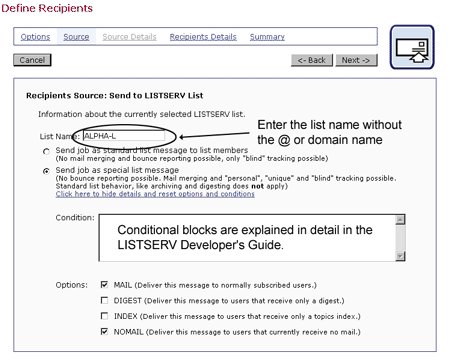
Setting a "Condition" is a means of creating a subset of recipients from the selected LISTSERV list based on information in a database. For information on setting conditions for a LISTSERV list, see the LISTSERV Developer’s Guide, available online at http://www.lsoft.com/manuals.html
There are four "Options" for a LISTSERV list that can be set by checking the adjacent boxes. The options are standard LISTSERV settings that subscribers may have set for their subscriptions.
- MAIL – Will deliver the message to all normally subscribed users.
- DIGEST - Will deliver the message to users that receive only a digest.
- INDEX – Will deliver the message to users that receive only a topics index.
- NOMAIL - Will deliver the message to users that currently receive no mail.
Click Next -> to continue.
4.2.4 Letting LISTSERV Select Recipients From a Database
The option "Let LISTSERV Select Recipients From a Database" relies on a pre-existing configuration of LISTSERV connected to a database or databases, whereas LISTSERV acts as the communicator between the database(s) and LISTSERV Maestro. This option may only be used if LISTSERV® has been set up to work with a database or databases. The site administrator should consult the LISTSERV Developer’s Manual for details.
If LISTSERV is connected to multiple databases, enter the "server name" defined in LISTSERV’s configuration in the "Database Server" textbox. Enter the SQL statement selecting the recipients in the "SQL Statement" textbox.
Figure 13 Define Recipients from LISTSERV Connected Database
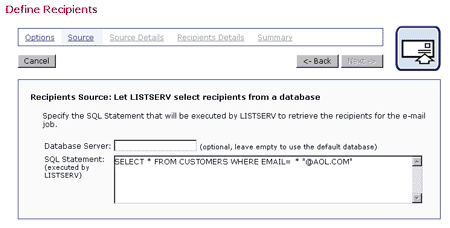
Click Next -> to continue.
4.2.5 Use Recipients Definition from a Previous Job
This option transfers all the data and settings from a previous job to the new job. The settings of the previous job will determine which Source screen is presented. It is possible to make changes in the selections available on the Source screen, or leave the selections the same as the previous job. Click Next -> to continue.
4.2.6 Determine Recipients Based on Reaction to a Previous Job
This option opens a Source screen that defines the original job and the conditions that potential recipients had to fulfill in the previous job to become eligible to receive the new message.
Figure 14 Define Recipients Based on Reaction to a Previous Job
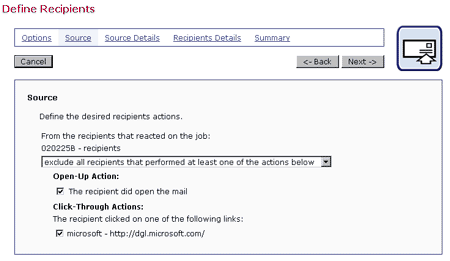
Select "include only recipients that performed at least one of the actions below" to include all those recipients who were part of the previous job and did react in the configured way - opening up the mail and/or clicking on a link contained in the message. Select "exclude all recipients that performed at least one of the actions below" to include all those recipients who were part of the previous job and did not react in the configured way. Next, select "Open-Up Action" and/or "Click-Through Actions." The resulting recipients list is based upon including or excluding recipients that performed a specific action in a previous job. Click Next -> to continue